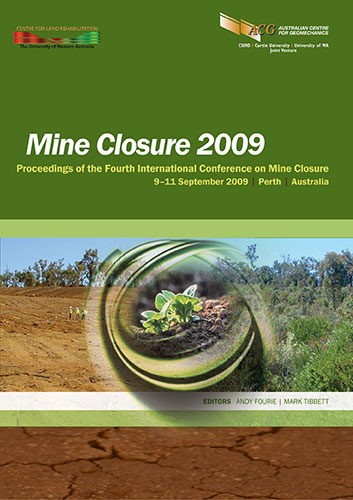Modified Blaney-Criddle method — an empirical approach to estimate potential evaporation using air temperature

|
Authors: Zhan, G; Lin Shelp, M |
DOI https://doi.org/10.36487/ACG_repo/908_35
Cite As:
Zhan, G & Lin Shelp, M 2009, 'Modified Blaney-Criddle method — an empirical approach to estimate potential evaporation using air temperature', in AB Fourie & M Tibbett (eds), Mine Closure 2009: Proceedings of the Fourth International Conference on Mine Closure, Australian Centre for Geomechanics, Perth, pp. 461-471, https://doi.org/10.36487/ACG_repo/908_35
Abstract:
Potential evaporation (PE) or potential evapotranspiration (PET, ETo) is one of the fundamental elements in the hydrologic cycle. The Blaney-Criddle (B-C) method is the simplest approach for estimating PE as it requires only temperature data for input. It has been found that the B-C method can provide accurate estimates for moderate climates. Under extreme climatic conditions the B-C method is inaccurate. This paper presents a modification to the original B-C method which was calibrated to the observed meteorological data at Barrick sites. The modified method estimates PE with improved accuracy and is applicable to a wide range of climate conditions (from 300 mm/y in humid climates to 4,000 mm/y in arid climates) and wind regimes. The proposed approach will provide a simple and practical PE (PET) estimation tool for mining engineers and hydrologists when dealing with mine-wide water management during life-of-mine and closure planning.
References:
Al-Darir, A.N. and Aldoubiat, M. (2005) The optimizing model of potential evaporation in North Syria, Ninth
International Water Technology Conference, IWTC9, 17–20 March 2005, Sharm El-Sheikh, Egypt, pp. 41-50.
Blaney, H.F. and Criddle, W.D. (1950) Determining water requirement in irrigated areas from climatological data, Soil
Conservation Service Technical Publication No. 96, Washington DC, US Department of Agriculture, 48 p.
Brouwer, C. and Heibloem, M. (1986) Irrigation water management: irrigation water needs, Chapter 3, FAO online
Brustaert, W. (1982) Evaporation into the atmosphere – theory, history and applications, D. Reidel Publishing
Company, London, England, 214 p.
deBruin, H.A.R. (1978) A simple model for shallow lake evaporation, Journal of Applied Meteorology, Vol. 17,
pp. 1132–1134
FAO (1998) Crop evapotranspiration – guidelines for computing crop water requirements – FAO Irrigation and
Drainage Paper 56, FAO online document, viewed on 11 July 2009,
Harmsen, E.W., Gonzalez, P.A. and Winter, A. (2003) Estimating long-term average monthly evapotranspiration from
pan evaporation data at seven locations in Puerto Rico, NoAA-Crest/NASA-EpscoR Joint Symposium for
Climate Studies, University of Puerto Rico - Mayaguez Campus, Puerto Rico, January 10–11, 2003, 7 p.
Appropriate cover systems — designing for perpetuity
Mine Closure 2009, Perth, Australia 471
Hill, R.W., Johns, E.L. and Frevert, D.K. (1983) Comparison of equations used for estimating agricultural crop
evapotranspiration with field research, Bureau of Reclamation, US Department of the Interior, E&R Center,
Denver, Colorado, 41 p.
Jensen, M.E. (ed) (1973) Consumptive use of water and irrigation water requirements, American Society of Civil
Engineers, New York, 215 p.
Monteith, J.L. (1965) Evaporation and environment, Symposia of the Society for Experimental Biology, Vol. 19,
pp. 205–234.
Papadopoulou, E., Varanou, E., Baltas, E., Dassaklis, A. and Mimikou, M. (2003) Estimating potential
evapotranspiration and its spatial distribution in Greece using empirical methods, Eighth International
Conference on Environmental Science and Technology, Lemnos Island, Greece, 8–10 September 2003, pp. 650-
658.
Penman, H.L. (1948) Natural evaporation from open water, bare soil, and grass, Proceedings of the Royal Society,
London, A193, pp. 120–145.
Stewart, R.B. and Rouse, W.R. (1976) A simple method for determining the evaporation from shallow lakes and ponds,
Water Resources Research, Vol. 12, pp. 623–628.
Wright, J.L. (1990) Estimating crop evapotranspiration, evapotranspiration and irrigation water requirements, M.E.
Jensen, R.D. Burman and R.G. Allen (ed), American Society of Civil Engineers, New York, pp. 112–131.
© Copyright 2024, Australian Centre for Geomechanics (ACG), The University of Western Australia. All rights reserved.
View copyright/legal information
Please direct any queries or error reports to repository-acg@uwa.edu.au
View copyright/legal information
Please direct any queries or error reports to repository-acg@uwa.edu.au